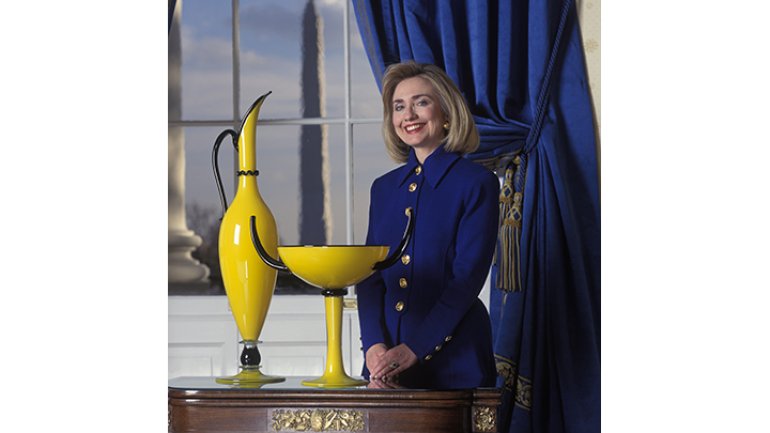Remembering an Unusual Exhibition at the White House
Today, a 25th-anniversary exhibition opens at the Clinton Presidential Center in Little Rock, Arkansas, and it’s sparking vivid memories for those involved in the original 1993 show. “The White House Collection of American Crafts: 25th Anniversary Exhibit” features 73 works (by 78 artists) that were installed in the Clinton White House to mark a yearlong celebration of craft. President George H.W. Bush had proclaimed 1993 the “Year of American Craft” the year before, and the Clintons – in what today would be a rare display of bipartisanship – were eager to carry out Bush’s plan.
Curator Michael Monroe recalls the show as a whirlwind effort he’s glad he doesn’t have to repeat. In April 1993, First Lady Hillary Rodham Clinton invited him across the street – he was curator-in-charge at the Renwick Gallery at the time – to talk about creating an exhibition in the White House that year. As he began to grasp her timetable, he worried. Instead of the usual two or three years to curate a show, he’d have six months. “My knees were knocking,” he says, “because I knew professionally that I should not say yes.” But who turns down a First Lady?
Monroe went right to work, making his way through the rooms of the White House with Mrs. Clinton and an official photographer, who captured scenes that could be good spots for a craft object. The next day, a slew of photos arrived at the Renwick, and Monroe began flipping through books, show catalogues, American Craft and Ceramics Monthly magazines, marking potential works for the White House with Post-it Notes. He aimed for a balance of ages, mediums, genders, education levels, and geography. He didn’t want an elitist craft who’s who, he says; he wanted “real living objects for real living people in a beautiful setting.” He showed his first cut to Mrs. Clinton; “you’re on the right track,” he recalls her saying. He finished that part of the process, including reaching out to the artists for specific pieces, in two weeks.
Monroe felt rushed, but he knew this was an opportunity. “I knew if I didn’t do it on this super-fast timeline, the artists wouldn’t have gotten the benefit of it,” he says. “I knew the White House would have that cachet that would propel these artists’ careers.” And several artists agree that having their work there, beginning in December 1993 and continuing through 1994, had major benefits. North Carolina artist Michael Sherrill remembers Monroe coming to his booth at an ACC show and selecting his Incandescent Bottles from a new barium body of work. He was surprised; he’d come from another show featuring the work where he’d sold nothing. It was a heartening lesson for him. “It’s not always what you’re doing; it’s the audience,” he says. Monroe’s recognition came at the right time. “All artists need affirmation,” he says, “especially when the work is not like anyone else’s.”
Monroe’s choice of Pennsylvania ceramist Cliff Lee’s Peach Vase on a Pedestal was another turning point. “I got a lot of publicity, a lot of exposure,” Lee recalls. “My career started taking off.” He recalls the First Lady doing a segment on Good Morning America about the show. Amazingly, his Peach Vase was front and center in the shot. “All my phones – my business phone, my personal phone – started ringing. My oldest son and I kept answering, saying, ‘Thank you. Yes, we know.’ It was exciting,” he says. He’s delighted the show is being reprised at the Clinton Center. “If I knew it was such an important, historical event,” he says, “I would have donated a whole truckload of my work.”
No government money was spent on the exhibition, Monroe points out. All but three artists donated objects; the three found donors to fund their gifts.
Once all of the pieces were installed at the White House, Monroe found new reasons to be adaptable. He’d go across the street every few weeks to check on the collection, only to find that things had been moved around. “I had to get used to that,” he says. “This was a very flexible, fluid, non-museum-like environment.”
One day, he entered the Blue Room, which had been set up with eight tables for a dinner. At the center of each table was a craft object. Some of the vessels had been filled with flowers; candles had been plopped inside Albert Paley candlesticks. (Imagine the dripping wax.) “I had to let go of the preciousness and see this as a working collection,” Monroe says. “This was craft really being functional.” No object in the collection was ever damaged or lost, he points out – although a handmade doll did disappear into Chelsea’s room for a time. “The staff took great care,” he says.
In 1995, two days after the Oklahoma City bombing, the collection opened as a show at the Smithsonian American Art Museum; Mrs. Clinton gave a moving speech about the importance of honoring people who make things in a time of destruction.
From there, the “White House Collection of American Crafts” traveled to 10 other museums through 1999. Now, more than 18 years later at the Clinton Center, the show is organized by medium and reuses the wooden labels from the 1995 Smithsonian show. A mini-documentary featuring interviews with Cliff Lee, Robyn Horn, Po Shun Leong, Josh Simpson, Randy Stromsoë, Toots Zynsky, and Frank E. Cummings III will play in the gallery. The exhibition runs through March.






